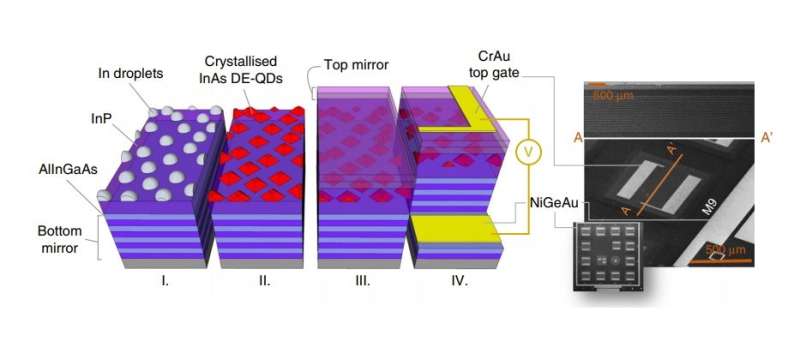March 9, 2018 feature
Entangled LED first to operate in the telecom window

Researchers have demonstrated the first quantum light-emitting diode (LED) that emits single photons and entangled photon pairs with a wavelength of around 1550 nm, which lies within the standard telecommunications window. A single-photon source that operates at this wavelength is expected to serve as a key component in future quantum networks, long-distance quantum communication systems, quantum cryptography devices, and other applications.
The researchers, Tina Müller et al., at Toshiba Research Europe Limited, the University of Sheffield, and the University of Cambridge, have published a paper on the new quantum light source in a recent issue of Nature Communications.
"For the first time, quantum devices can meet the fundamental requirements of state-of-the art quantum key distribution and quantum communication systems," Müller told Phys.org.
The ability to emit single photons and entangled photon pairs in the telecom window has been a goal in the field of quantum optics for a long time. Although a variety of different light sources exist that can emit single and entangled photons (from individual atoms to color centers in diamond), until now they have been largely limited to shorter wavelengths that are unsuitable for quantum network applications.
In the new study, the researchers fabricated light-emitting quantum dot devices based on indium phosphide, a material that is currently used in quantum dot lasers to generate laser light with a 1550-nm wavelength. To enable this material to emit single photons and entangled photon pairs at this wavelength, the researchers used a growth method called metalorganic vapor phase epitaxy to grow individual indium phosphide quantum dot "droplets," which form the basis for the quantum LEDs.
Another advantage of the new quantum LEDs is that they can operate at temperatures of up to 93 K, which is significantly higher than the operating temperatures of other quantum light sources. A higher operating temperature allows for easier integration with existing devices, and the researchers expect that the operating temperature of the new devices could be improved even further with some modifications.
Going forward, the researchers anticipate that the new quantum LEDs will have a significant impact on the development of quantum network technology, including the quantum internet. For example, the devices can be integrated with quantum relays and repeaters to extend the range of quantum networks. The researchers also expect that the quantum light sources can operate in pulsed mode when integrated with radio frequency electronics. Their next steps will be to make improvements in order to realize these applications.
"We will further optimize the performance and size of our devices to facilitate integration in long-distance quantum communications systems," Müller said.
More information: T. Müller et al. "A quantum light-emitting diode for the standard telecom window around 1,550 nm." Nature Communications. DOI: 10.1038/s41467-018-03251-7
Journal information: Nature Communications
© 2018 Phys.org


















